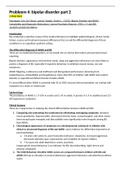Probleem 4: bipolar disorder part 2
1. Busy Dave
Marangoni, Ciro, De Chiara, Lavinia, Faedda, Gianni L.,. (2015). Bipolar Disorder and ADHD:
Comorbidity and Diagnostic Distinctions. Current Psychiatry Reports, 17(8), 1–9. doi:DOI
10.1007/s11920-015-0604-y
Introduction
We conducted a selective review of the medical literature to highlight epidemiological, clinical, family
history, course and treatment-response differences that can aid the differential diagnosis of these
conditions in an outpatient pediatric setting.
The differential diagnosis of ADHD and BD
There are no established biomarkers, so we should rely on clinical observation and parental/school
reporting.
Bipolar disorder: appearance of prominent mood, sleep and aggressive behaviours are more likely to
predict a diagnosis of BD, especially if impulsive behaviour is exhibited around money, sex and
substances.
ADHD: fidgeting, restlessness and inefficient and disorganized performance stemming from
inattentiveness, distractibility and forgetfulness. More than 50% of children with ADHD had conduct
disorder or oppositional defiant disorder besides ADHD.
It’s most difficult when ADHD is comorbid with CD or ODD, because their presentation can overlap with
symptoms of a manic or mixed state.
Epidemiology
The prevalence of ADHD is 1.7-16% in youths and 1-5% in adults. It persists in 1/3 in adulthood and 2/3
still experiences symptoms.
Clinical features
There are 3 approaches in studying the clinical differentiation between ADHD and BD:
1. Comparing and contrasting two syndromes by eliminating overlapping symptoms: elevated
mood, grandiosity, hypersexuality, decreased need for sleep, racing thoughts, and other mania
items except hyper-energetic and distractibility were significantly more frequent among BD
than ADHD.
2. Chronological appearance of symptoms on a developmental continuum in children with
clinical or structured diagnosis of BD and ADHD: some evidence for differential trajectories of
psychopathology.
a. 1-6 years old: tantrums, poor frustration tolerance, impulsivity, increased aggression,
decreased attention span, hyperactivity and irritability for bipolar children
b. 7-12 years old: adult depression, mania, psychosis.
Inappropriate sexual behaviour is an indicator for BD, also bedwetting, night terrors and
physical complaints.
3. The Child Behaviour Checklist (CBCI) scores are compared between children with BD and
ADHD: BD had an elevation of anxious/depressed, aggressive behaviour and attention problems
scales.
, Differences in specific symptoms
Hyperactivity
Bipolar disorder: chronic or intermittent periods of intense hyperactivity, often with impulsivity
and aggression. Greater productivity and also low periods of activity, exhaustion and boredom.
Circadian rhythms are altered, eveningsness.
ADHD: restlessness, fidgeting, hyperactive behaviour especially when focus is needed. Relative
stable levels of locomotor activity.
Sleep disturbance
Bipolar disorder: frequent fluctuations of energy levels, including rapid cycling. Especially
middle and late insomnia
ADHD:
Mood, suicidality and psychosis
Bipolar disorder: severe irritability, dysphoria, crying spells, temper tantrums and mood lability.
Also suicidality, death ideation, suicidal ideation and attempts
ADHD: mood fluctuation and dysregulation, mood symptoms ae secondary to academic or
social difficulties and have bedtime resistance.
Aggressive and hypersexual behaviour
Bipolar disorder: various forms of aggression, planned aggression with lack of remorse. Also an
increased interest in sexual images.
ADHD: verbal and physical aggression can result from irritability while the destruction of
property is accidental, related to inattention, impulsivity and poor coordination. Hypersexual
behaviour is NOT part of ADHD.
Academic functioning
Bipolar disorder: variable, uneven performances
ADHD: poor concentration but it’s consistently over time and across subjects.
Family history
Most significant risk factor for developing BD is positive family history. It’s genetic influence.
Course
Bipolar disorder: the majority experiences temperamental mood symptoms before the first
episode.
ADHD: follows a chronic and unremitting course and persists into adulthood in half of the cases.
Zie de tabel want die is belangrijk!!




